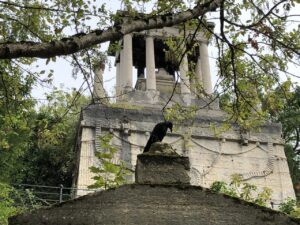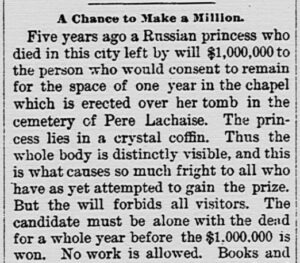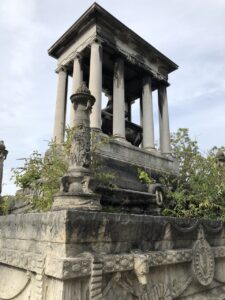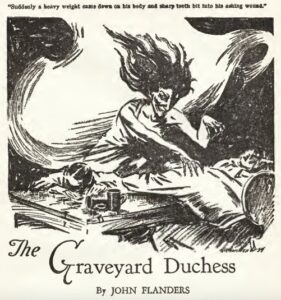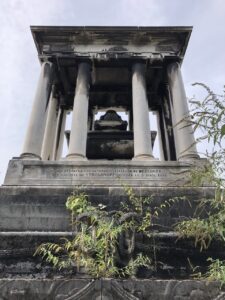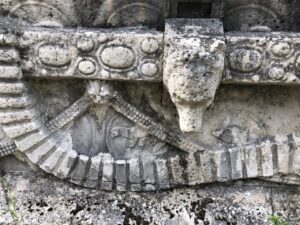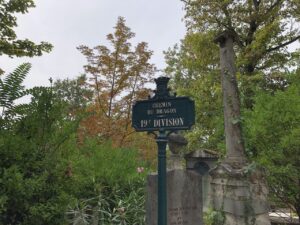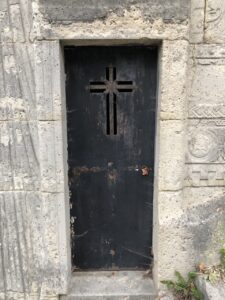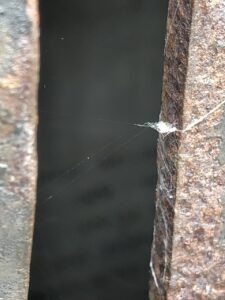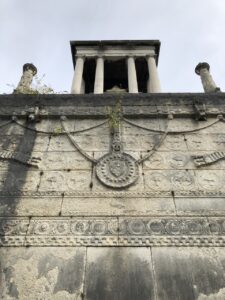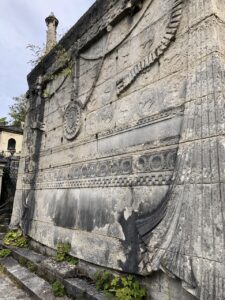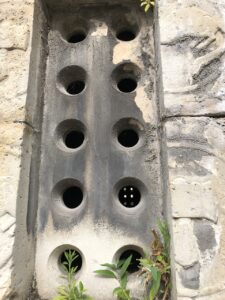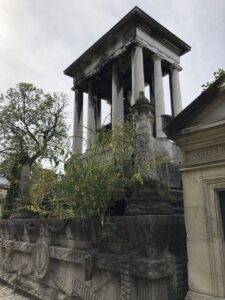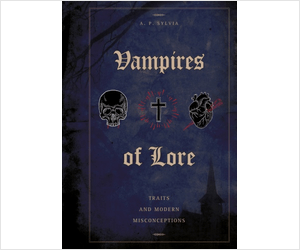Among the graves of Père Lachaise Cemetery in Paris is an elaborate mausoleum upon which a strange story has become attached. According to legend, it houses the remains of a Russian princess whose last will and testament promises a fortune to anyone who can spend one year, alone, inside her tomb. Her body lies inside a glass coffin within a chapel room lined with mirrors. As such, anywhere an intrepid visitor may look, they would see the visage of the mysteriously well-preserved princess. Those who attempted the feat failed after a short time, with some saying they felt their life force drained, and one having been driven mad. There’s even implications that the princess’ body rises from the grave and moves about the tomb. The exterior of the mausoleum supposedly features vampiric designs, such as stone wolf heads. It would seem this legend presents us with a vampire who developed a contest as a means to lure fresh victims to her resting place. Let’s unpack this story and see how it evolved.
The First Sources
The overall tale I provided above did not seem to enter into the public consciousness fully formed. Rather, different pieces have been introduced over time. The first versions of the story seem to have originated in newspapers and focused primarily on the contest. According to author Chris Woodyard, the earliest reference he could find was an article in the Chicago Daily Tribune, from October 25, 1893. This may be the first article to appear in US papers about the tale. Historian Stéphanie Sauget found an earlier version in the French newspaper La Justice, published on September 19, 1893. I’ll also mention that researcher Marie Beleyme sites an 1896 article in La Temps that states a boulevard newspaper (in France) originated the story a few years prior – thus supporting an 1893 Paris origin.
In my own research, I found assertions that the tale might have originated in Paris newspapers in 1890. One argument for this can be found in the December 26, 1893 issue of The Glasgow Herald, in an article called “An Extraordinary Hoax.” It opens by saying, “A paragraph which went the round of the Paris journals a few years ago stated in the most matter-of-fact language that a Russian Princess had left a million francs to any person who would…” – implying the story originated in Paris around 1890. The article seems to indicate that the story had reappeared in 1893 in a more robust form.
The 1890 date is explicitly given in the February 19, 1894 edition of the Daily Kentucky New Era, in an article titled “Paris’ Gigantic Hoax.” It states, “In 1890 an advertisement appeared stating that a deceased Russian princess left a million francs to be given to the person…” The article also discusses the deluge of inquiry letters received by the authorities, but then mentions something interesting about the reward. It says, “Then the wag of wags raised the ante. Five million was the sum next offered through the press.” This implies that the very first articles about the contest had a reward of 1 million francs. The 1983 Chicago Daily Tribune article states 5 million, as does the La Temps article, so perhaps an earlier version exists – though no one has yet to unearth it.
Wherever and whenever it appeared first, the story of the Russian princess’ grim challenge certainly caught on. Other papers carried the article and a number of subsequent stories were published around the US and other countries. Here’s an example from the October 31, 1893 issue of the Aurora Daily Express. I believe the text is the same as the first Chicago article.
A Curious Will Contest.
A curious will contest, according to Paris papers, is about to be tried in the Seine courts. Five years ago a Russian princess died, leaving a large fortune. There was great surprise among her relatives when the testament was opened. By one of its clauses she left 5,000,000 francs to the person who would remain a year in the chapel to be erected above her grave in the Pere la Chaise. The body of the princess, according to the legendary report, lies in a crystal coffin in a wonderful state of preservation. No one of her relatives has been able to remain longer than two or three days in the chapel. What will become of the 5,000,000 francs is the question.
While this particular article is fairly brief, more detailed articles would emerge. For example, here’s one published in The Watchman and Southron, December 27, 1893:
A Chance to Make a Million
Five years ago a Russian princess who died in this city left by will $1,000,000 to the person who would consent to remain for the space of one year in the chapel which is erected over her tomb in the cemetery of Pere Lachaise. The princess lies in a crystal coffin. Thus the whole body is distinctly visible, and this is what causes so much fright to all who have as yet attempted to gain the prize. But the will forbids all visitors. The candidate must be alone for the dead for a whole year before the $1,000,000 is won. No work is allowed. Books and newspapers, however, are permitted, and a servant brings meals regularly to the watcher. One hour’s walk a day is allowed, but this must be undertaken before 5 o’clock in the morning in summer and 8 o’clock during the winter months.Several Frenchmen have essayed to win the prize, but all have given up after a short trial. One lasted out nearly three weeks, by which time he had completely lost his reason and still remains a jabbering idiot. The will makes no mention of foreigners being ineligible. There is every chance, therefore, for a strong minded American who fears neither ghosts, ghouls nor gravestones to become rich in the short period of 365 days. Application is to be made to the municipality of Paris.
– Paris Correspondent.
This later article certainly provides much more logistical information about the contest, including the food arrangements and allowances for reading material and walks. It also converts the reward into US dollars (the conversion seems roughly accurate based on some quick searching I did about exchange rates during the time). These articles and similar variants appeared in numerous newspapers in late 1893, and they apparently caught the attention of would-be adventurers.
More stories were published about the princess’ will as we move into 1894, but they take a sharp turn. Rather than presenting the contest as factual, these later articles brand it as a hoax. They usually begin by providing a summary of the original story, often with additional details that must have been added as the tale gained traction. For example, it’s in one of these articles that I found mention of the plate glass mirrors lining the walls. They then discuss how the authorities in Paris have been deluged by letters from people all over the world asking if they can compete for the reward. These articles stress that there is no contest and no reward.
Who was this supposed Russian Princess?
In all of the articles, the Russian princess is never named. Besides her nationality and title, the only other clues we can infer are: that she died around 1888 and her tomb in Père Lachaise must be grand enough to hold a chapel.
In the later stories branding the whole affair a hoax, it’s stated that there is no Russian princess at all. Rather, the supposed tomb is actually owned by a French family named De Beaujour. There is indeed an elaborate grave in Père Lachaise for Félix de Beaujour, a French diplomat who was made a baron. He died in 1836 and his monument consists of a 20-meter tall round tower. However, aside from this singular assertion in the hoax articles, there doesn’t seem to be any other evidence linking de Beaujour to this contest.
Today, if you research this grave contest, you’ll find that modern articles identify a woman by the name of Elisabeth Demidoff as the deceased in need of company. She’s sometimes referred to as the “Vampire Baroness of Paris.” Other sources refer to her as a countess or princess. So, was she really the Russian princess buried in Paris? Let’s take a quick look at her life before visiting her final resting place.
Elisabeth Demidoff was born Elizaveta Alexandrovna Stroganova in either 1776 or 1779, in Saint Petersburg, Russian Empire. (Her surnames may also be spelled Demidov, Stroganov, and Stroganoff.) She was born into a noble family, and thus inherited the title of Baroness Stroganova. In 1795, she married Russian industrialist Nikolai Demidoff. The pair lived in Paris and Italy, then returned together to Russia in 1812. After their fourth child was born in 1812, Elisabeth moved to Paris without her husband. Their separation may have been due to differing personalities, with Elisabeth being much more social and outgoing than her husband. In 1827, the Grand Duke of Tuscany granted Nikolai the title of Count of San Donato, in recognition of a silk factory he helped establish. Thus, this would make Elisabeth Demidoff a countess by marriage.
After a brief illness, the countess died on April 8, 1818 in Paris. Her youngest son, Anatoly, arranged for an elaborate mausoleum to be built for her. This same son was awarded the title of Prince of San Donato by the Grand Duke of Tuscany. This was done so Anatoly could marry the niece of Napoleon without her losing her princess title. Thus, while Elisabeth Demidoff wasn’t technically a princess, herself, she was the mother of a prince.
It would seem that Elisabeth Demidoff is the closest match to a Russian princess buried in Père Lachaise. Her tomb (which we’ll discuss more about below) is quite impressive and does look big enough to contain a room. Her year of death was many decades before 1888. However, her actual date of death, April 8, 1818, does include three 8’s – so perhaps the 1888 date is simply a mix up. Or, perhaps the original article writer was just aiming for a fanciful tale and the year didn’t really matter. Ultimately, past conservators of Père Lachaise have stated that there is no contest, and no one seems to be aware of any such will promising a fortune for a yearlong stay. However, regardless of overall accuracy, Elisabeth Demidoff has come to be placed front and center in this legend.
Vampire Elements
While the vampire element of this legend is well established today, the first stories don’t mention it specifically. At best you see general references to cemeteries being frightful places, like in the above quoted article that mentions a candidate who “fears neither ghosts, ghouls nor gravestones.” However, language more akin to a vampire comes up in some later articles. Here’s an example from the Calgary Herald, February 27, 1894:
“Paragraphs began to appear in the papers stating that several intrepid watchers had already abandoned the task on account of the uneasiness of the dead princess. In other words, she has the disagreeable habit of getting out of the glass coffin and walking about in her shroud.”
While this quote may be suggestive of the undead, it doesn’t quite explain the fullness of the current legend. However, it may be that the vampire elements present today may actually originate from a work of fiction.
In 1917, the short story Das Grabmal auf dem Père Lachaise was published in German. Written by Austrian author Karl Hans Strobl, the title translates into English as The Mausoleum on the Père Lachaise. The story is a first-person narrative in which a researcher agrees to spend a year inside the mausoleum of a wealthy Russian woman named Anna Feodorowna Wassilska. He is forbidden to speak with anyone except the servant who brings him his two daily meals. As time goes on, the narrator comes to believe that Madame Wassilska is a vampire, materializing in the chamber at night and biting him to drain his blood. It’s clear that Strobl must have known about the articles concerning the Russian princess in Père Lachaise. Using that as a starting point, he then took things in a vampiric direction. It appears the story was also published in French in 1979 and 1986.
There’s another work of fiction that seems to be inspired by the Russian princess, though it deviates a bit more. Le Gardien du Cimetière is a short story written by Jean Ray (aka John Flanders) and first published in 1919. Translations have appeared in other languages in various years. In English, the story was published as The Guardian of the Cemetery and The Graveyard Duchess in 1934 and The Cemetery Watchman in 1965. In this story, a new watchman is hired to help guard the cemetery of Saint-Guitton, which contains the elaborate mausoleum of Duchess Opoltchenska. His salary, and that of two other guards, is paid via a legacy left by the duchess – ostensibly so that the valuables in her tomb would be protected. As this new guard spends time there, he comes to realize the sinister nature of the situation: the other watchmen are former servants of the duchess, and she is actually a vampire that has been feeding on him.
It’s interesting that these short stories bear a striking resemblance to the legend of the Vampire Baroness. Perhaps these fictional works helped influence the folklore we find today.
The Mausoleum
The resting place of Elisabeth Demidoff, Baroness Stroganoff is an imposing mausoleum positioned high up in the cemetery. The top consists of a neoclassical portico, within which is an antique sarcophagus. This all sits atop a massive base, elaborately carved with symbols including wolf heads, hammers, sables (an animal similar to a weasel that’s native to Russia), and a large carved knot on the front. Inscribed on the tomb is:
Ici Reposent les Cendres d’Élisabeth de Démidoff,
Née Baronne de Strogonoff Décédée le 8 Avril 1818.
The symbols are certainly striking – especially the wolf heads, which are often incorporated into the legend as being guardians of the sleeping vampire. It is usually assumed that the hammers and sables are there to represent the sources of the Demidoff wealth (mining and fur). The legend links the three number 8s in the date of death to the symbol for infinity and thus the eternal life of the undead. It also associates the carved knot to the joining of life and death.
Within Père Lachaise are numerous named paths. The Demidoff tomb is located in the 19th division, on the Chemin du Dragon (Path of the Dragon). This naturally conjures up associations to Dracula and thus is another element in the vampire legend. I’ll also note that there are stairs that descend down from the mausoleum to the Chemin des Chèvres (Path of the Goats) and terminate on the Avenue des Acacias. As such, sometimes directions will list those other paths, but the Path of the Dragon is the most direct and least stair-heavy.
Interestingly, the mausoleum was originally located in a different section of the cemetery. When it was built, it only consisted of the portico. In 1852, it was moved to its current location and placed upon the elaborately carved base. The base is built into the side of the hill, so its height is striking when looked at from the lower paths.
The mirror-lined chapel referenced in the news articles, if it did exist, would have to be located in this large base structure. However, from what I could see on my visit, this does not appear to be the case. On the south side of the base is a metal door with a cross-shaped window in it. If you look within, you can see crypts for other members of the family. There doesn’t appear to be any chapel or open room, and no light reflected from mirrors.
There are also grated windows on either side of the base, about halfway up. Because of the stairs that run along the side of the tomb, you can get at eye level with one of the windows. Looking through, light from the opposite window can be seen, with darkness inside the structure itself.
Thus, it seems a number of elements in the old newspaper articles don’t quite line up with the mausoleum of Elisabeth Demidoff. Firstly, if her will had called for this contest, it’s surprising the original monument didn’t have space for someone to live in. Rather, the large base was added 34 years later. Secondly, from what I could see at least, there isn’t a mirror-lined chapel inside. Lastly, while the legend talks about the princess’ body resting in a glass coffin, it may be that the body of Elisabeth Demidoff was cremated. The epitaph on her monument states that it’s her ashes (cendres) that are entombed there.
Conclusion
The true origin of the Russian princess and her postmortem prize may never be known. It seems clear that the story originated in the newspapers of Paris in the 1890s, before becoming a global sensation. However, the very first version of the tale remains lost. Was the story intended to be a hoax, as many subsequent articles claimed, or was there some kernel of truth or misunderstanding? It seems, as more articles were published, more extravagant details were added. The vampire elements appear to have been added later, likely influenced by short works of fiction that used the Russian princess tale as inspiration. This captivating story, combined with the striking nature of the mausoleum itself, not to mention the overall ambiance of Père Lachaise, has made for an enduring legend.
A visit to Père Lachaise is well worth the time for anyone who appreciates funerary art and Victorian garden cemeteries. There are numerous monuments of significance and burials of prominent people (such as Oscar Wilde, Jim Morrison, Frederic Chopin, and Edith Piaf). I enjoyed my time exploring the many different paths and areas, and appreciated the elaborate tombs and atmosphere of this memorable cemetery.
Location
The cemetery is located in the 20th arrondissement of Paris.
There are five entrances to the cemetery – all allow pedestrians and two allow vehicles.
The official address is:
Cimetière du Père-Lachaise
16 rue de Repos
75020 Paris
France
The mausoleum is located in Division 19, on the Path of the Dragon.
Refer to the official map for the mausoleum and entrance locations.
View Sources
“Anatoly Demidov, 1st Prince of San Donato.” Wikipedia, last modified April 8, 2024. https://en.wikipedia.org/wiki/Anatoly_Demidov,_1st_Prince_of_San_Donato.
Beleyme, Marie. “Le mausolée Demidoff.” Père-Lachaise: 1804-1824, June 5, 2016. https://perelachaisehistoire.fr/le-mausolee-demidoff/.
Castleton, David. “Baroness Demidoff – the Glass-Coffined ‘Vampire Princess’ of Père Lachaise Cemetery.” The Serpent’s Pen, May 19th, 2021. https://www.davidcastleton.net/baroness-demidoff-pere-lachaise-cemetery-paris-glass-coffin-vampire-russian-princess-will/.
“A Chance to Make a Million.” The watchman and southron. [volume] (Sumter, S.C.), 27 Dec. 1893. Chronicling America: Historic American Newspapers. Lib. of Congress. <https://chroniclingamerica.loc.gov/lccn/sn93067846/1893-12-27/ed-1/seq-2/>
“A Curious Will Contest.” Aurora Daily Express, October 31, 1893. https://books.google.com/books?id=3bMoAAAAIBAJ&pg=PA4.
“Élisabeth Alexandrovna Stroganoff.” Wikipédia, last modified March 4, 2024. https://fr.wikipedia.org/wiki/%C3%89lisabeth_Alexandrovna_Stroganoff.
“Elizaveta Alexandrovna Stroganova.” Wikipedia, last modified February 5, 2024. https://en.wikipedia.org/wiki/Elizaveta_Alexandrovna_Stroganova.
“An Extraordinary Hoax.” The Glasgow Herald, December 26, 1893. https://books.google.com/books?id=t7FEAAAAIBAJ&pg=PA3.
Flanders, John. “The Graveyard Duchess.” Weird Tales, vol. 24, no. 6, December 1934. https://archive.org/details/Weird_Tales_v24n06_1934-12_sas.
“A Great Hoax.” The Bryan Democrat, May 10, 1894. https://books.google.com/books?id=PJZPAAAAIBAJ&pg=PA3.
“A Great Parisian Hoax.” Calgary Herald and Alberta Livestock Journal, February 27, 1894. https://books.google.com/books?id=3xBlAAAAIBAJ&pg=PA7.
Hall, Ashley. “Elisabeth Demidoff Mausoleum.” The Paranormal Guide, April 20, 2013. http://www.theparanormalguide.com/blog/elisabeth-demidoff-mausoleum?view=full.
“Jean-Louis Voille (Paris 1744-c. 1805), Portrait of Elizaveta Alexandrovna, Baroness Stroganova (1776-1818), later Countess Demidova, half-length.” Christie’s. https://www.christies.com/en/lot/lot-6067862.
Lovejoy, Bess. “The Russian Countess Who Supposedly Wanted Company in Her Tomb.” Mental Floss, October 25, 2019. https://www.mentalfloss.com/article/604841/russian-countess-tomb-pere-lachaise.
Map of Père-Lachaise Cemetery. Mairie de Paris. https://www.api-site.paris.fr/paris/public/2018%2F9%2FCPLMapEN.pdf.
“Paris’ Gigantic Hoax.” Daily Kentucky New Era, February 19, 1894. https://books.google.com/books?id=RUUaAAAAIBAJ&pg=PA5.
“Paris’ Gigantic Hoax.” The Democratic Standard, February 9, 1894. https://books.google.com/books?id=tYlmAAAAIBAJ&pg=PA7#v=onepage&q&f=false.
Renard, Jean-Bruno. “The legend of the Russian Princess of Père-Lachaise.” Spokus, April 18, 2023. https://spokus.eu/pere-lachaise-princesse-russe-cercueil-verre/.
Robert Lefèvre, Public domain, via Wikimedia Commons. https://commons.wikimedia.org/wiki/File:Elisabeth_Stroganoff,_comtesse_Demidoff.jpg.
Strobl, Karl Hans. “Das Grabmal auf dem Père Lachaise,” in Das unheimliche Buch, 5th ed., edited by Felix Schloemp, Munich: Georg Müller, 1914. https://www.projekt-gutenberg.org/strobl/grabmal/titlepage.html.
“Title: Das Grabmal auf dem Père Lachaise.” Internet Speculative Fiction Database. https://www.isfdb.org/cgi-bin/title.cgi?1882011.
“Title: Le gardien du cimetière.” Internet Speculative Fiction Database. https://www.isfdb.org/cgi-bin/title.cgi?1058284.
Woodyard, Chris. “The Tomb Challenge of the Russian Princess.” Haunted Ohio Books. http://hauntedohiobooks.com/news/the-tomb-challenge-of-the-russian-princess/.
Written by A. P. Sylvia

